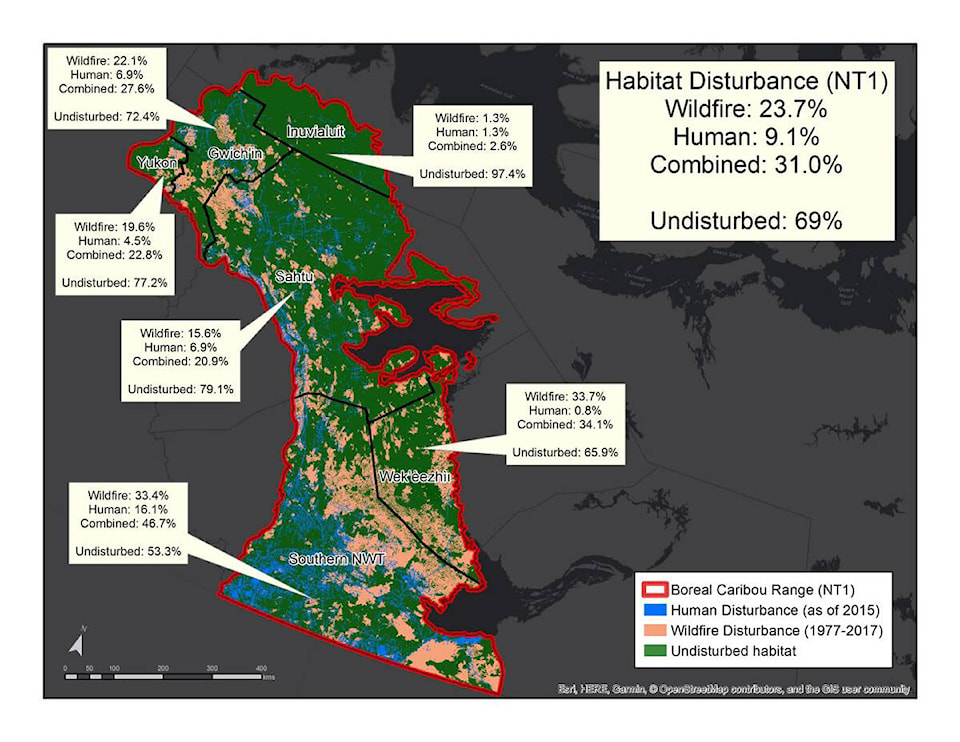Infrastructure planning must take into account the impacts on boreal caribou if the elusive herds are to survive climate change, and an Environment and Natural Resources project is aiming to establish how to do just that.
As part of an ongoing consultation process, a meeting to update the public on how a Boreal Caribou Range Plan is coming along was held Dec. 8 at Ingamo Hall.
Known in Gwich’in as Vadzaih and Inuvialuktun as Tuktuk or Tuttut, boreal or “shire” caribou differ from Bathhurst, Bluenose and Tuktoyaktuk caribou — collectively known as Barren Ground caribou — in a number of ways. Living in the dense forest, they don’t gather in massive herds like their tundra-brethren.
Instead, they keep to small groups numbering 20 at a maximum, which with the overlying canopy makes establishing population numbers extremely daunting. It is currently estimated there are 6,500 boreal caribou in the NWT, though the last official counts in the NWT were in 2011, with the most recent population estimates completed by the Yukon government in the winter of 2020 to 2021. A second effort to count the NWT-side caribou will be conducted this winter. Tuktuk are also typically larger than their cousins, are known to run faster and don’t go on large migrations.
While the NWT is working to update its own numbers, boreal caribou range planner Lisa Worthington said the recent data suggests the boreal caribou are doing relatively okay in the NWT, in spite of being listed as threatened in the NWT in 2014. So now was the time to begin conservation efforts.
“The range plans are trying to plan for the future,” said Worthington. “So that we can maintain enough undisturbed habitat so boreal caribou can maintain their own healthy population. We’re trying to do that by managing large scale activities like forestry, oil and gas or roads or anything like that.
“Then we’re going to create management plan maps that guide future development.”
Boreal caribou have been listed as threatened Canada-wide since 2003, and a national recovery strategy was written first in 2012 and updated in 2020.
Their position is at its most precarious in northern Alberta and British Columbia, where roads, cut lines and infrastructure from mining and forestry development disturb the animals in a number of ways. For starters, wide open spaces, roads and cutlines give predators like wolves the edge when hunting caribou, because the caribou rely on the thick vegetation to keep a safe distance from them. Uninterrupted forest and muskeg is needed to allow caribou to use their evolutionary adaptations effectively.
Accustomed to the dark silence of the deep woods, boreal caribou are also particularly sensitive to bright lights and noise, which typically follow almost any human development. Caribou are also heavily affected by changes to the forests themselves, either by the clear cutting or natural burning of old growth forests. Younger forests attract grazers like moose. The moose are followed by wolves, who then hunt the more vulnerable caribou.
With all this in mind, the GNWT is working to develop five separate range plans to cover the habitat of the vadzaih. Using a combination of scientific and traditional knowledge, conservationists are working to identify areas vital to caribou self-sustenance and establishing development rules for future infrastructure. The range plans do not affect individual harvesting quotas or rules, but instead focus on the long-term effects of large infrastructure on the ecology.
Each section of natural habitat in a range plan will be ranked to one of three categories: basic, enhanced and intensive protection.
Basic protection will encourage best practices but does not come with any major restrictions and is assigned to lands least needed by the caribou. Enhanced protection will be given to those areas more needed by caribou and in these areas any development should be limited to already disturbed area. Further disturbances to the area must have a restoration plan to proceed. In Intensive protection area, only land already disturbed is permitted for development and steps need to be taken to ensure proper restoration of the land as well as protecting key forest from potential wildfires.
Range planning biologist Maria Ciancio said the goal was to keep 65 per cent of caribou habitat undisturbed across the NWT. Currently, 71 per cent is undisturbed. In the Beaufort Delta, the goal is to keep 70 per cent of habitat undisturbed. Already established infrastructure, such as the Inuvik-Tuktoyaktuk Highway, will be grandfathered into the range plans.
Each range plan will run for 10 years, with a review after the first five. Once the 10 year period has passed, the program will be updated and started over.
“It’s kind of like a land-use plan, but for caribou,” said Ciancio. “We’re trying to plan for caribou to have enough habitat to be healthy.
“All we need to do is give them enough space and they can take care of themselves. We’re trying to plan for where the development goes so we can save the good spots for the caribou so they can roam around and get what they need.”
A few more information meetings are scheduled for this year. Once the Range Plan working group has enough information to properly develop the maps, they will be reviewed with stakeholders before the range plan is finally implemented.
